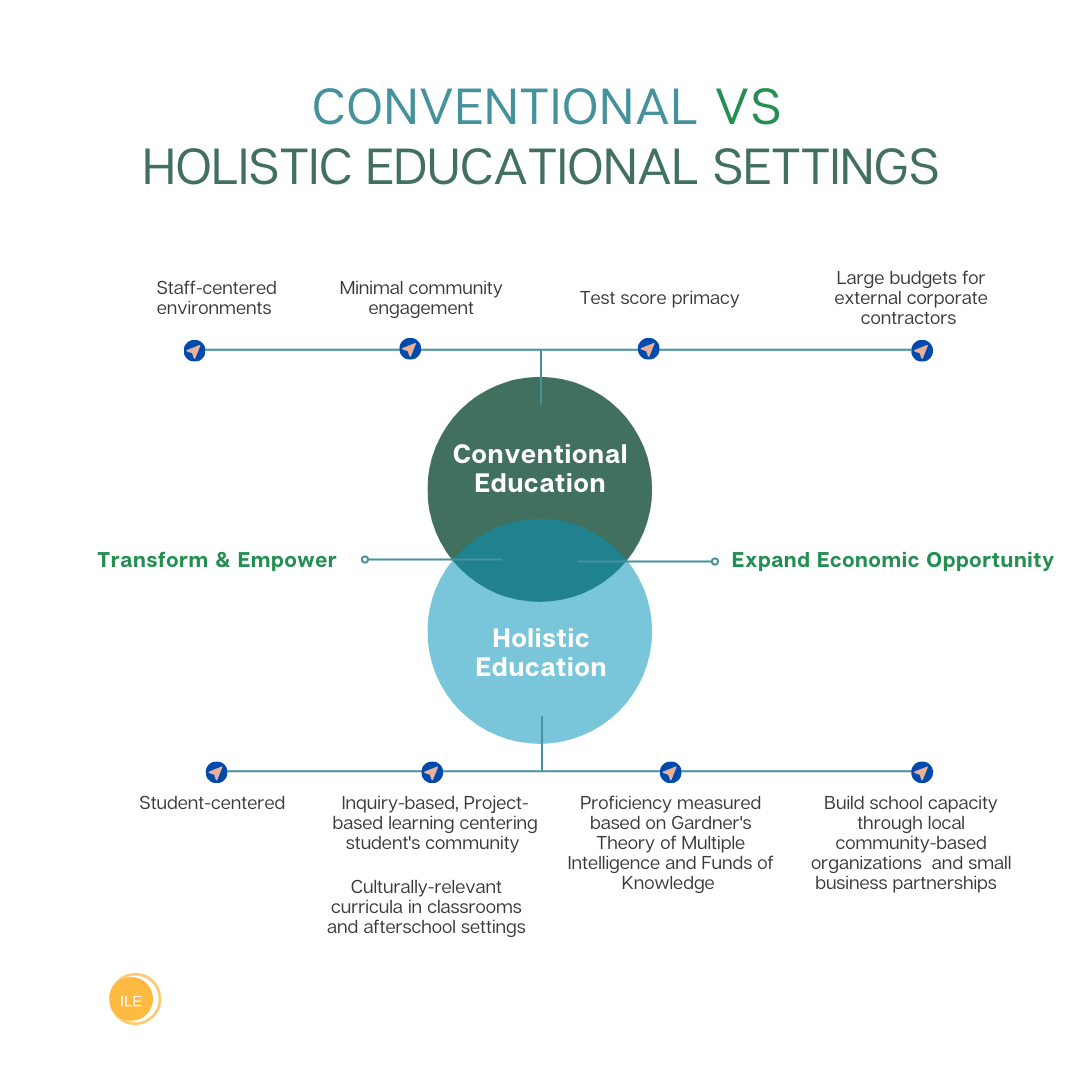
STEM Education in the US
The United States seeks to expand tech competitiveness through a number of policy measures and fund allocations in the coming decades. However these measures, from our analysis, does little to address the challenges of those who largely comprise our future workforce, including current middle, high school and college students attending public schools. Millions of students across the country live in what has been termed STEM deserts – lack of tech access, meaningful STEM (Science, Technology, Engineering and Math) education and face increasing tech-driven marginalization.
More important than our quest for tech dominance is having students well-equipped for work in STEM fields to avoid workforce deficiencies in numerous sectors important to citizens’ wellbeing such as health care, climate change resilience and cybersecurity.
These challenges exist in a school system that was not designed to promote equitable opportunities and outcomes.
The existence of STEM deserts is a critical equity issue in education and overall economic wellbeing, particularly for students in urban and rural communities, where access to high-level math and science courses are often out of reach. A small percentage of schools across the country offer computer science instructors and well-equipped technology labs required for adequate instruction. The pandemic and the need for remote learning revealed the staggering number of students who have limited access to secure and consistent broadband and personal computing devices. These challenges exist in a school system “that was not designed to promote equitable opportunities and outcomes”, as stated by Pamela Cantor, AFT.
Soon, the impact of students learning STEM deserts and inadequate school environments will not only be reflected in those students’ high school and college completion rates and career prospects, but it will also take a toll on the country’s economic competitiveness technological leadership and national security.
Policy Insights : US Innovation of Competition Act of 2021
The US Senate recently passed the US innovation and competition Act of 2021 a $250 billion bill focused on investments in the technology sector with the aim of bolstering the country’s global competitiveness in advanced technological development. The bill also provides directive for an overhaul of the National Science Foundation a federal agency that promotes and advances scientific research. Though a quarter of trillion in US-backed tech investment is nothing to sneeze at, China’s investments far exceeds that of the US. China has a massive plan to surpass the US as a premier tech producer 2050. According to an analysis by the FBI, China allocated 15% of its gross domestic product on improving human resources from 2008 to 2020. China has already exceeded many strategic priorities for recruitment in foreign talent and state-backed venture capital investments. Comparatively the US innovation and competition Act of 2021 is a drop in the bucket representing a little over 1% of US GDP.
Investment in developing and recruiting STEM must include significantly more funding and investments in education and technology access for all citizens. 17 million Americans lack access to broadband technology. And millions more are “under-connected” with limited access to devices or unreliable broadband access. According to a report by New America the majority of students learning remotely this year experienced disruptions in their education due to being under-connected. More than half (53 percent) of remote students experienced one of these type disruptions at some point during the past year.
Fund allocations should include support and rewards for entities working to improve equity in STEM education access, including local and state government agencies, community-based organizations and small businesses.
As explained in a 2019 Code.org Advocacy Coalition report: in most states, computer science is a new subject. In order to make computer science a fundamental part of the education system, states will need to create roadmaps to address a number of policy and implementation issues. Having articulated goals for computer science education and strategies will be key. Equitable access to K–12 culturally-relevant and affirming computer science education must be at the foundation of our states’ plans.
Computer science education is crucial for processing vasts amounts of data that will contribute to greater understanding and monitoring of pandemics, climate change and resiliency measures, cybersecurity among other important societal issues.
Boosting Public Investments in Holistic STEM Education
If our gaps in STEM education are left unaddressed, we will continue to exclude entire populations from this fast-growing field and miss out on the innovations and contributions that diversity promotes.
While academics continuously conduct advocacy and research around high quality STEM education access efforts to to date lack engagement of parents and communities. Students’ communities are the the environment in which students live, play and socialize. These environments play a major role in student success in STEM learning. Community-based organizations have a large role to play here. They are on the frontlines of filling gaps in public services. They provide safe spaces for children after school, with homework and tutoring support. They connect families job training and social benefits. While there are some successful partnerships between schools and CBOs providing supplemental tech training, these relationships are not institutionalized and lack sustainable funding needed for such collaborations.
School environments are typically staff-centered with minimal community engagement. Culturally-relevant and affirming curricula is frowned upon (i.e the highly politicized debate around critical race theory). Test scores rule with little attention to whether students retain and apply knowledge. Schools have limited capacity and time for student engagement, but are often giving the green light to out-source admin and “innovative” learning projects to external corporate contractors. Students and teachers who fall out of line with this model are punished. Black children in particular suffer greatly under this model.

As Pamela Cantor poignantly outlines a framework to guide the transformation of learning settings for children and adolescents in the Fall 2021 issue of AFT’s magazine to create holistic environments for learning that centers students’ experiences and communities. Cantor sites guiding principles such as positive developmental relationships, environments filled with safety and belonging, rich learning experiences and knowledge development, development of skills, habits and mindsets and integrated support systems.
Applying these principles in a STEM classroom would require student-centered teaching using inquiry and project based learning in classrooms and in enrichment programs in their communities. In lieu of test scores, knowledge proficiency could be measured using frameworks such as Funds of Knowledge and Gardner’s Theory of Multiple Intelligences which personalizes learning. Finally local community organizations and small businesses would be engaged in providing additional coaching, mentoring, safe spaces to study and apprenticeships.
A Note on the Infrastructure Bill and the Build Back Better Act
At the time of this post, the $1.75 trillion infrastructure bill that President Biden hopes to get through Congress is supposed to expand job creation and generate opportunities across many industries. It also includes efforts to expand access to broadband for communities with limited or no connectivity. The paradox here is that among the industries to be tapped to complete this work (namely construction and tech workers), there is a labor crisis due to the rapidly dwindling workforce to complete the work outlined in the bill.
The Build Back Better Act according to the House Committee Education and Labor highlights many key areas of social support for working families. And while it addresses much needed funding for preschool and higher education there is limited fund allocation for K-12 education and STEM education.
We will continue to update this post as these details unfold. Are you an educator, advocate, tech worker or small business? Email us and share your perspective.
##
References:
US News. The US Must Address Disparities in Access to STEM Education. (2017)
Staff Report: Threats to the US Research Enterprise: China’s Talent Recruitment Program
Advocacy.org 2019 State of Computer Science
